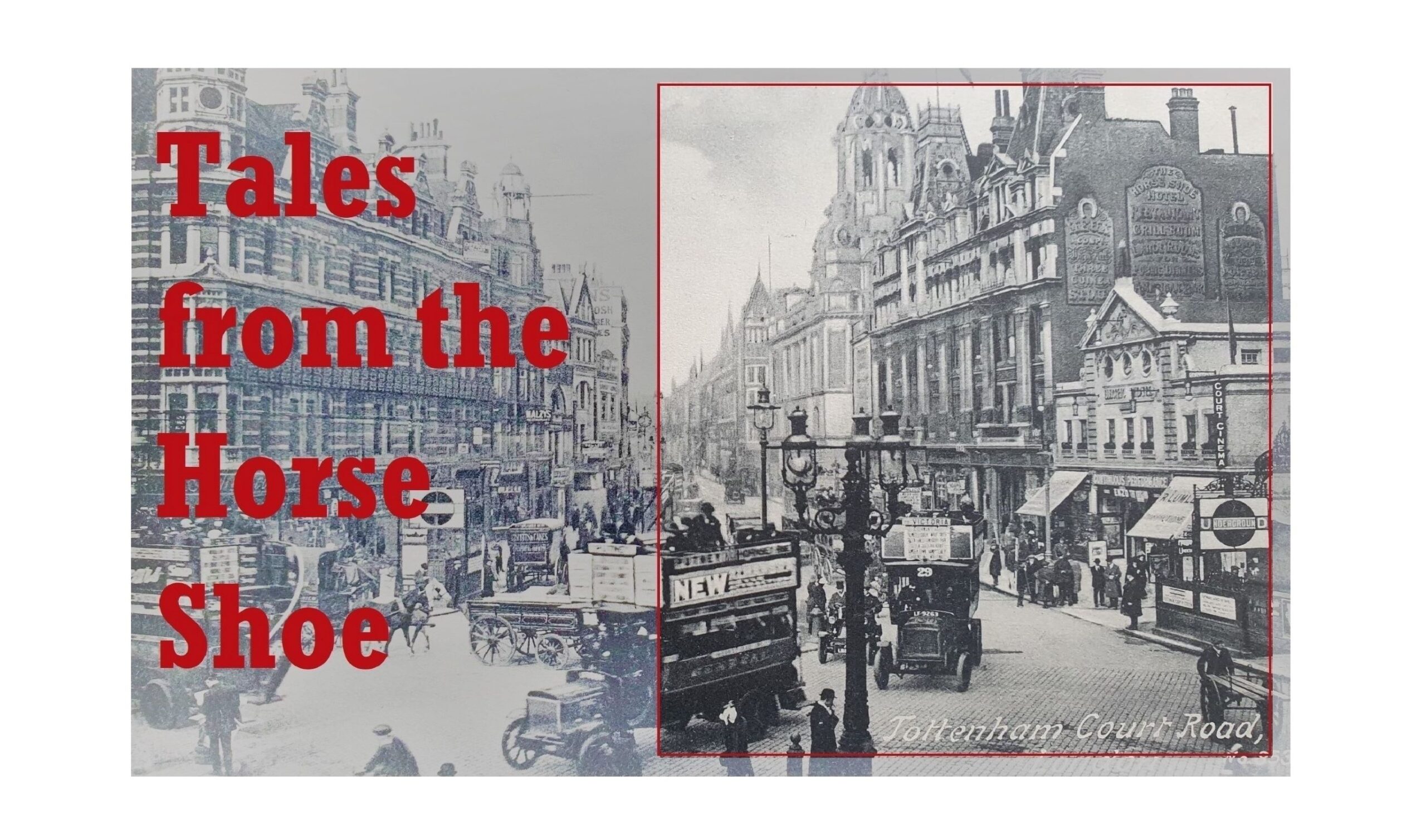
You may not know St Giles Circus, at least not by that name. The junction of Oxford Street, New Oxford Street, Charing Cross Road and Tottenham Court Road is colloquially known as ‘Centre Point’ after a 33-floor 1960s office block. But ignore for a moment that monstrous monument to property speculation, and focus on the north-eastern corner of the junction, where once a huge brewery stood. Pull up a chair, pour a glass of beer and make yourself comfortable – for there be tales of tragedy and murder to tell.
The area was rural when, in the 12th century, a leper hospital was founded by King Henry I’s wife Matilda, just south of what later became the brewery site. By the time of the reformation, there were no lepers remaining and the land was seized by the Crown. The hospital chapel became the parish church of St Giles in the Fields, and development of the area began in the early 17th century. By the mid-18th century it was a slum district known – as many such areas were – as the rookery.
The Horse Shoe Brewery (c.1746-1922): London’s Great Beer Flood
A brewery existed on the site by 1746 and grew steadily. In 1794 the owner, John Stephenson, drowned there in a cooler vessel. It was an ominous portent.
Henry Meux (pronounced ‘Mews’), a scandal-prone brewer seeking new opportunities, bought the establishment in 1809. It was known as the Horse Shoe* by 1813, and concentrated on producing a strong, dark beer known as porter. This needed a long period of storage in vats to mature.
* The name appears as two words until the final days of the hotel, so I will adhere to this form throughout.
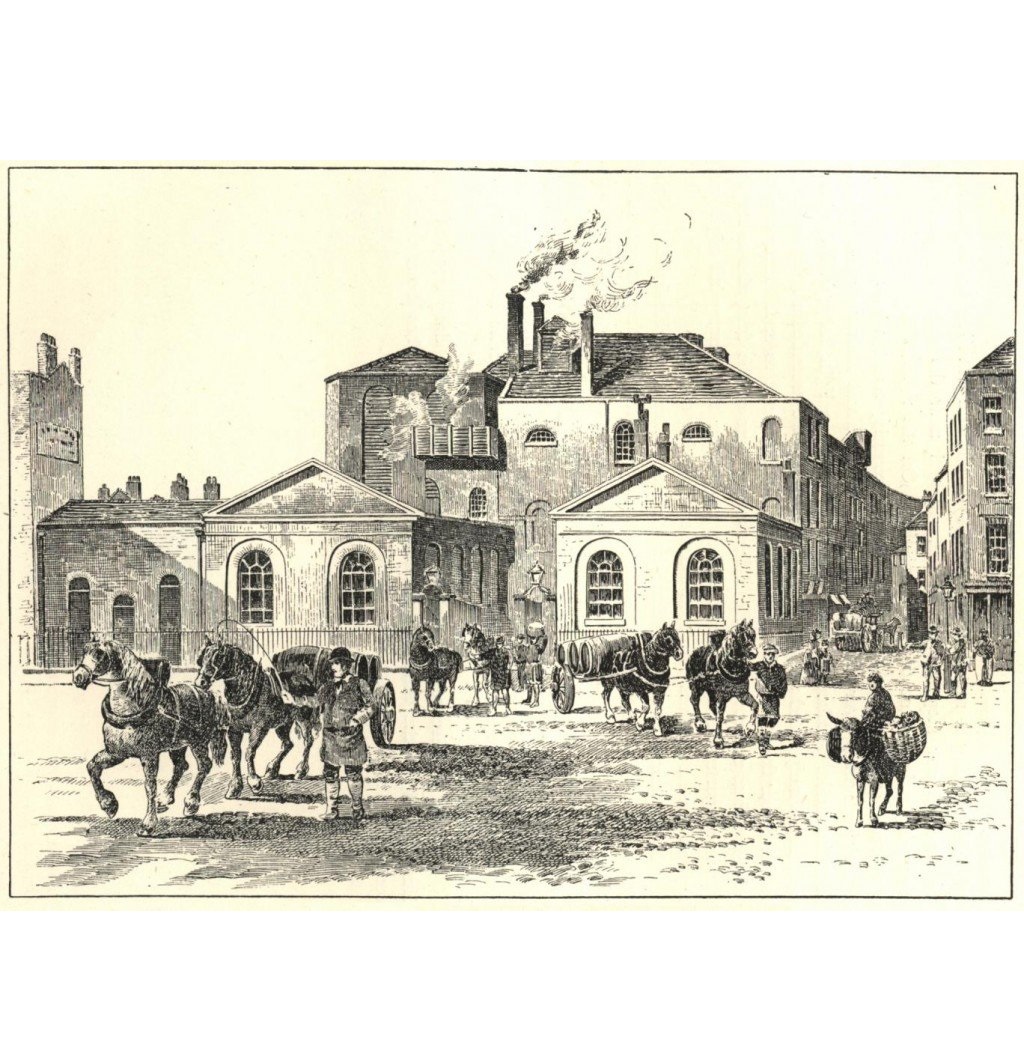
← This illustration of the brewery entrance on Tottenham Court Road dates from the early 19th century. On the right is Bainbridge Street, leading into the rookery. This part of the slum was swept away by the later creation of New Oxford Street.
The brewery storage area held a large number of these colossal vats, monuments to the cooper’s art – the largest supposedly held the equivalent of 18,000 barrels. This area was at the east end of the brewery, behind houses fronting onto Great Russell Street, George Street (now Dyott Street) and New Street. George and New Streets were part of the rookery; most residents were Irish immigrants.
On 17th October 1814, a storehouse clerk, George Crick was checking a smaller vat. He noticed that the lowest iron hoop, weighing perhaps 350 kg, had fallen off. The vat held 3,500 barrels – a million pints. It was said to be 22 feet high, and was close to the Brewery’s outer wall. Hoops fell off vats occasionally when rivets failed and this had not previously caused problems, Crick later stated.
This time it did. At around 6 pm the vat burst. A 15-foot wave of maturing porter took out another vat below, the brewery wall and part of the roof. The rear walls of houses and the Tavistock Arms pub in Great Russell Street were badly damaged by collapsing masonry, as were buildings in George Street. Two houses in New Street were completely demolished. Basements flooded with porter.
There are no newspaper reports of drunkenness or attempts to ‘liberate’ beer during the disaster – onlookers were well-behaved and aided the rescue efforts of residents and authorities as the extent of the tragedy unfolded. The first body identified was the 14 year-old servant of Richard Hawse, proprietor of the Tavistock Arms. She had been in the back yard, and was buried under brewery rubble. Her name, ironically, was Eleanor Cooper. The other victims lived in New Street. Hannah Banfield, aged 4, was swept away by the torrent of beer. Sarah Bates, aged 3, was found dead in the street. Other victims included Elizabeth Smith, a bricklayer’s wife; Catherine Butler, an Irish widow, Mary Mulvey and Mary’s 4-year-old son, Thomas. These four were attending a wake in a cellar in New Street following the death the day before of the young son of the eighth and final victim, Ann Saville. The death toll may have been worse if the vat had given way an hour later, by which time many working men would have returned home.
The inquest decided the incident was an ‘Act of God’, so Meux did not have to pay compensation. However, the brewery had lost a large amount of stock and suffered severe structural damage. Parliament passed the Allowance of Duty to Meux and Company Act 1815 which allowed the brewery a credit of £7,250 (around £650,000 today) against future excise duties, effectively compensation for the duty already paid on the lost beer. The brewery was repaired and expanded.
The Bloomsbury Hotel and Congress House, the TUC headquarters, cover the site of the beer flood.
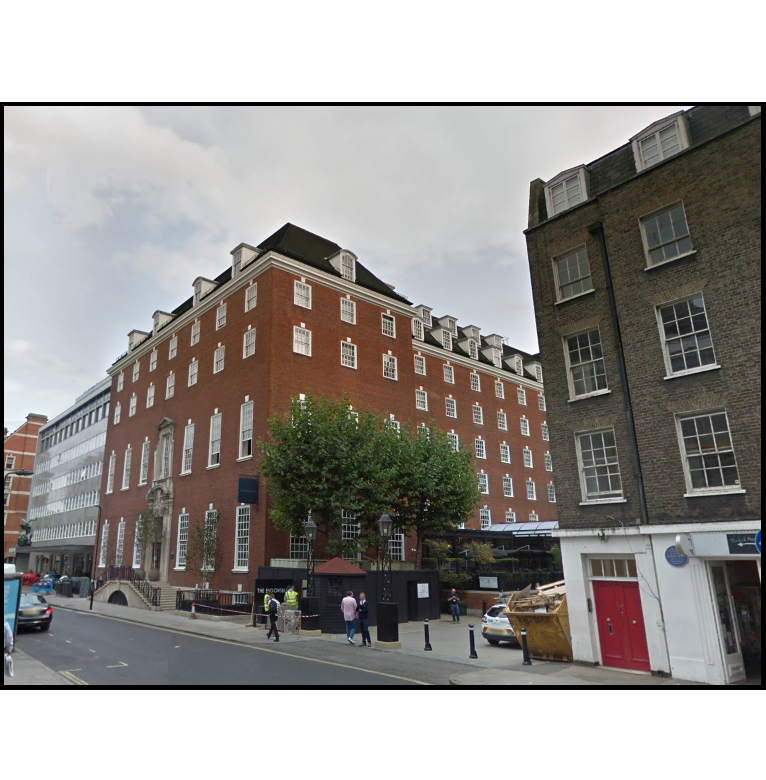
→ Great Russell Street. The red-brick Bloomsbury Hotel with the grey 1960s facade of Congress House beyond. New Street was a short cul-de-sac now under Congress House, running parallel to Great Russell Street.
The brewery, out of place in an area that was never heavily industrial, survived until 1922. In 1925 most of the site became ‘Luna Park’, a mainly charitable endeavour containing a large temporary theatre used for variety shows, a ‘Continental Cafe’ and various side shows. However, there was speculation that a permanent theatre would be built on the site, and Luna Park quietly closed soon after opening.
The Court Cinema (1911-1928): Trading with the Enemy
The brewery stabling and hay lofts had been sold off and demolished in 1911 to make way for the Court Cinema. This picture house, visible in the title image, became very successful after introducing an Italian orchestra to accompany the films. However, a majority of the shares in its parent company were owned by Germans and three directors were also distinctly Germanic. Despite all 200 employees being British, and the company being a British venture which had turned to German finance only when insufficient capital was raised in the UK, the Government Board of Trade liquidated the company under the terms of the recent Trading with the Enemy Amendment Act 1916. The Kinematograph and Lantern Weekly lamented its demise, admitting that it was ‘excellently and economically managed’, and that German investors had been better than their British counterparts at spotting a good prospect.
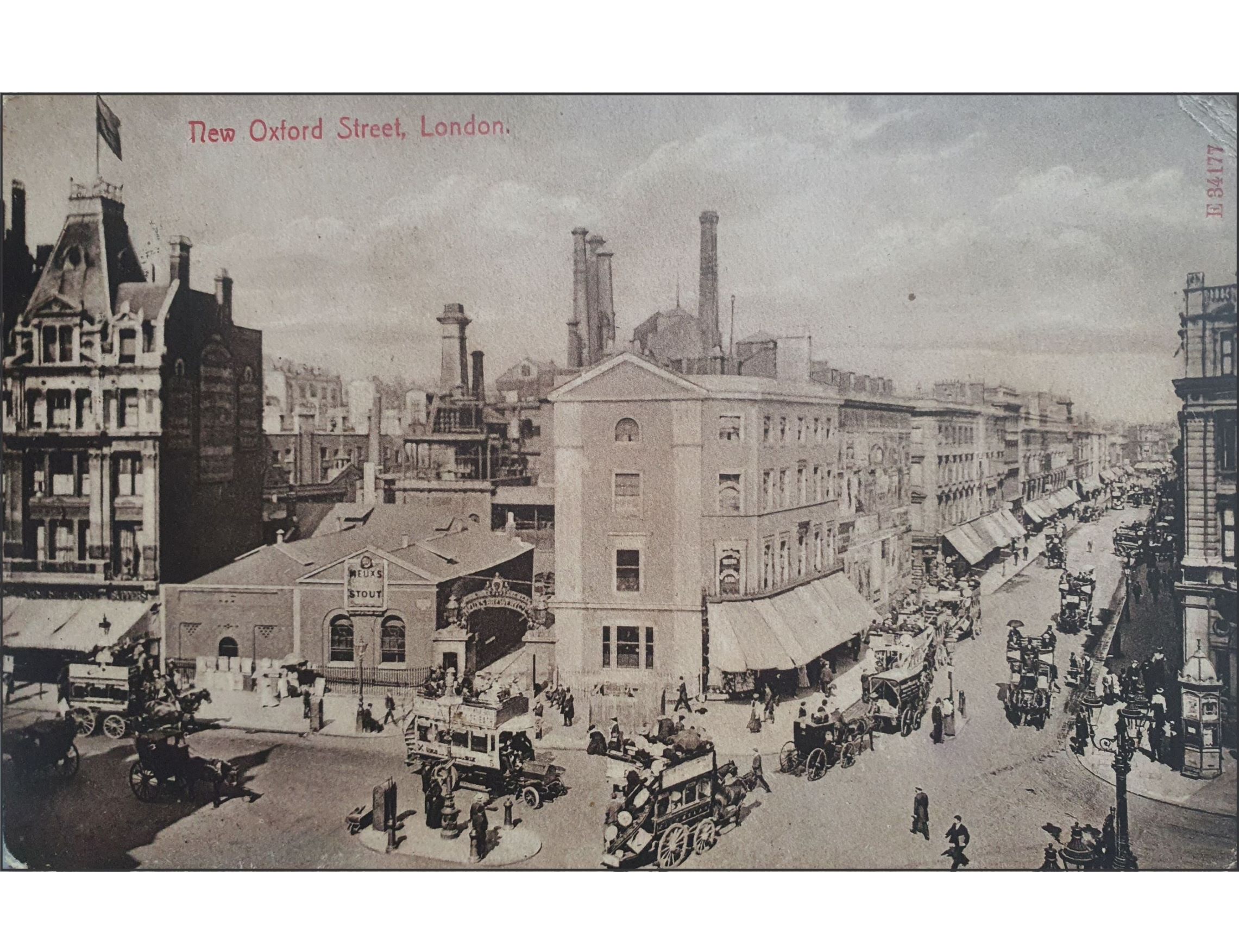
← The stables, shown shortly before demolition, are the low buildings centre left. New Oxford Street , pushed through the rookery, is on the right. The chimneys of the brewery give a strangely industrial look to the West End.
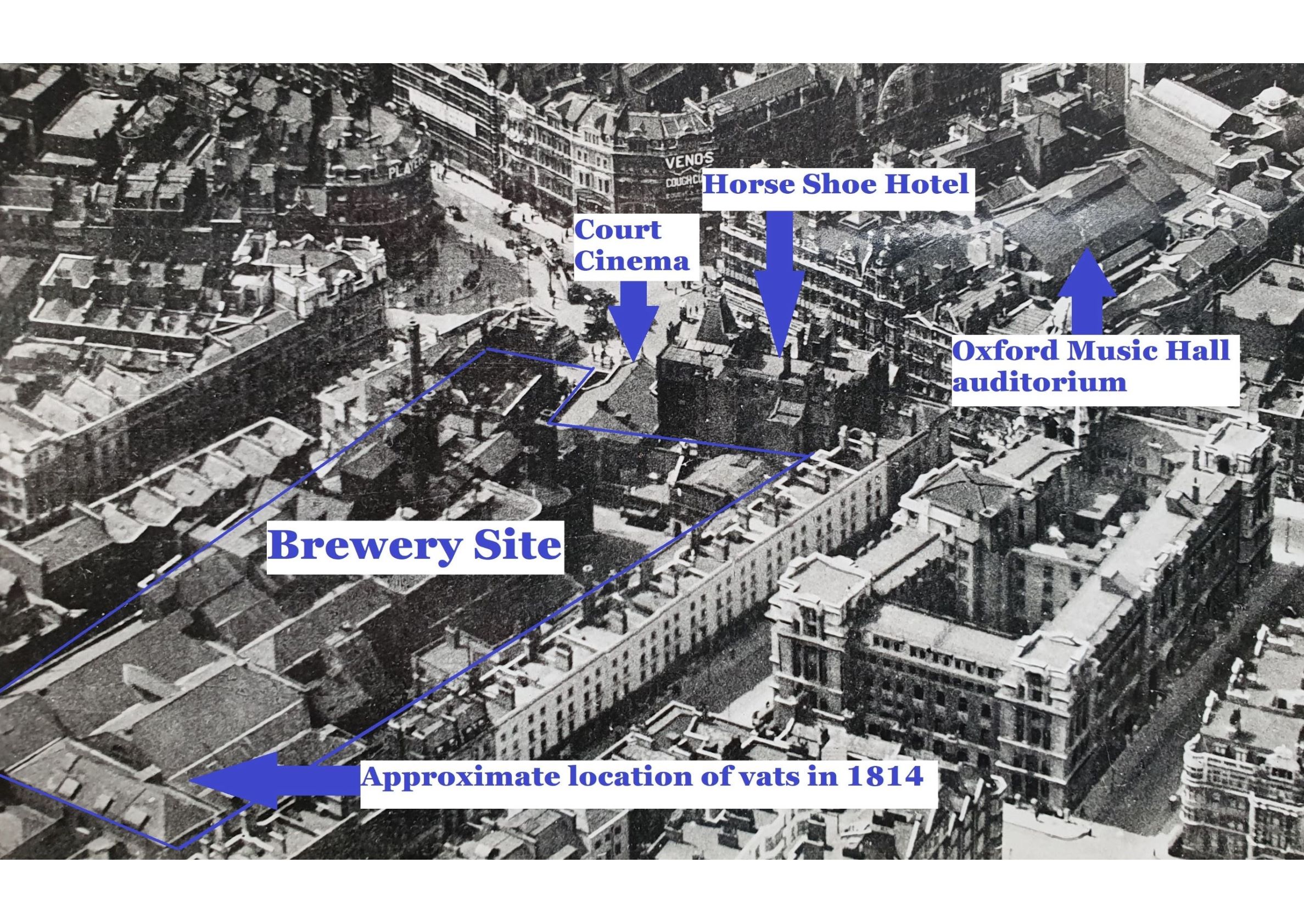
← By later standards the Court was a small cinema. In this early aerial view it is dwarfed in size by the nearby Oxford Music Hall auditorium.
Under the very British ownership of Mssrs Chambers and Smurthwaite, it became the Court Imperial Cinema before changing hands again and concentrating on films of a dubious sexual nature. It closed in March 1928 when the lease expired, after a 4-week run of a film on the dangers of venereal disease – single-gender screenings only, of course. A fortnight later fixtures and fittings were advertised for sale in the Bioscope, with a Gaumont Chrono De Luxe projector a snip at just £32.
This short-lived flea-pit was demolished soon after. The speculation had been right – a ‘super-theatre’ was to be built on the brewery and needed the site of the tiny cinema for its entrance and lobbies.
The Dominion (1929): Architectural failure hits paydirt with greatest-hits musical
The vast Dominion replaced both Luna Park and the Court Cinema at a cost of £500,000. It might have been called a theatre, and was fitted out as one, but the investors hedged their bets – the auditorium feels more like a super-cinema, and was fitted with a film projection room. Uniquely, the lobby was built with a direct connection to Tottenham Court Road underground station via its own subway.
Things didn’t start well for the new theatre. No good can possibly come of opening with a musical about golf, particularly with the title Follow Through. Sure enough, within a year the Dominion was showing talkies. It was rather more successful in this role and – escaping serious damage in the Blitz – continued mainly as a movie house until the early 1980s, by which time cinema was seemingly in terminal decline.
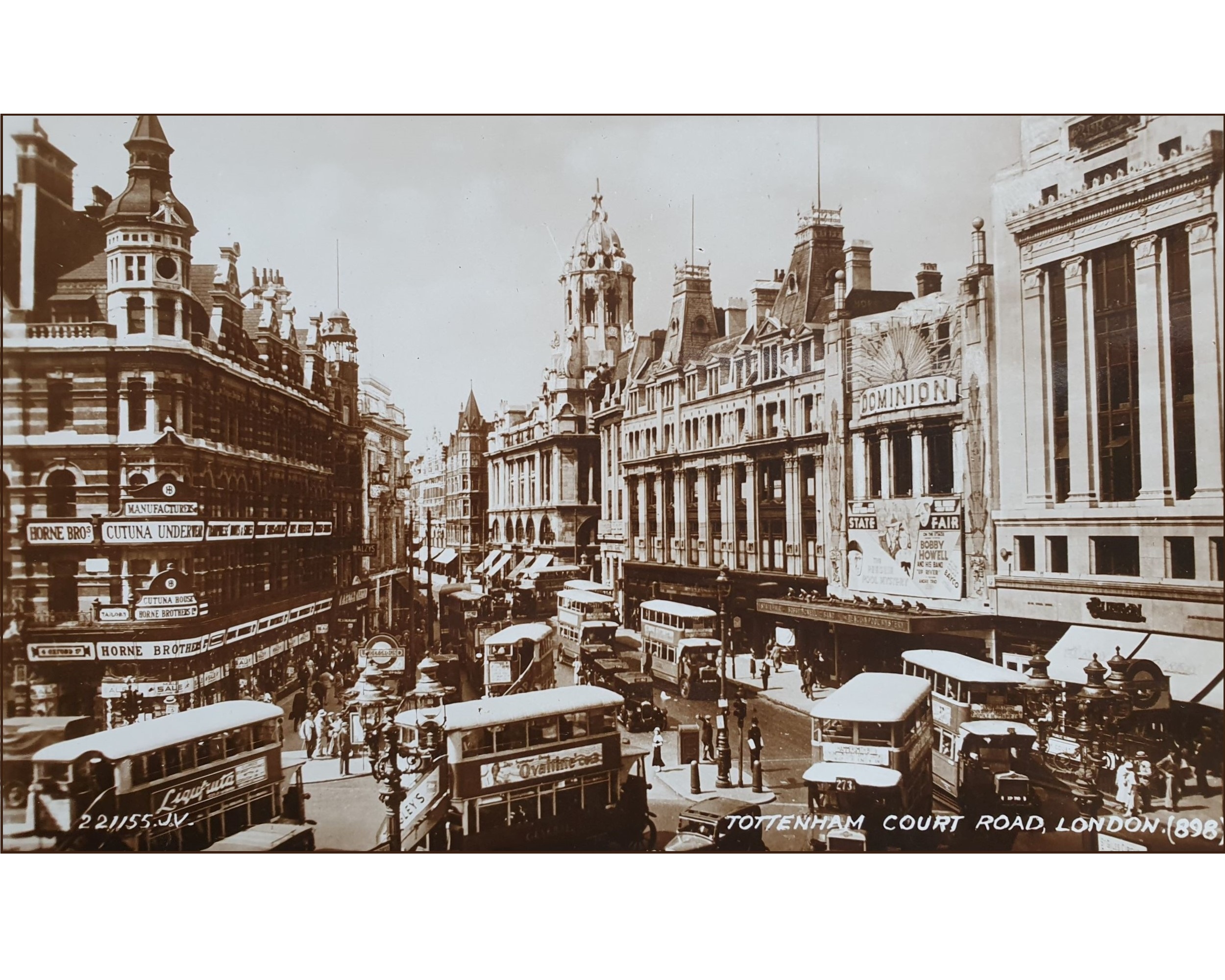
→ This 1933 view of the Dominion shows a new neighbour: Far right is the 1930 Corinthian House, HQ of Burton’s Tailoring.
In the distance, with a spectacular corner tower, is the YMCA – demolished in the 1970s.
Music concerts and musical theatre made a comeback, but hotel accommodation in London was in short supply and the Dominion represented a prime site, perfect for providing that accommodation to those who visit London to enjoy things like music concerts and musical theatre. By the late 1980s property developers were casting glances at the building, and in 1989 the blow fell – plans were published to redevelop the site.
It was at this point that Victor Glasstone, a theatre historian, must have regretted his unflattering 1982 description of the Dominion’s architects, W. & T.R. Milburn. He thought them ‘… highly trained architects who, on the evidence of their later work at least [i.e. the Dominion], had no feel whatsoever for the theatre’. He added that the Dominion had been ‘built at a time when theatre design was nearly at its lowest ebb’. Just seven years later, it was all-hands-on-deck to save the building, trying to extol its virtues to council planning committees while the developers probably quoted Glasstone’s own lines. Somehow, the campaigners won, but we need to face reality: the Dominion is not very good. However, no one is likely to build a theatre on this scale again – capacity is still above 2,000 even with the balcony closed – so it’s worth keeping.
Admittedly, it has had some clunkers in its second stint as a theatre. Remember the technical glitches of Time, and the three week run of the woeful Bernadette? But then there was Grease, and Beauty and the Beast, and the twelve years of We Will Rock You. With a restoration completed in 2014, the Dominion’s future looks bright.
The Horse Shoe Hotel (1875-2007): Murder, Folk-Rock & the end of an era
In 1846, the Fox and Hounds public house was first recorded at 264 Tottenham Court Road. Ten years later it had been joined by the Horse Shoe Brewery Tap at 267 – a tap is the nearest outlet for a brewery’s beers. In 1875, the Horse Shoe Hotel was built on the site of the Fox and Hounds, and twenty years later this was extended over the tap, completing a building that would last for 112 years.

→ Half way there: The large 1875 hotel block sits next to the earlier brewery tap, awaiting its own 1895 redevelopment
In its early 20th century heyday the building seems to have concentrated on food and drink rather than accommodation. It contained only 16 bedrooms by this time, but also billiard rooms, restaurant, grill room, café-bar, saloon, luncheon bar, function rooms, wine shades, a dive bar – it was actually called that on the plans – and even a Masonic temple. It was the café-bar that featured in the hotel’s most notorious episode.
On the morning of 27th September 1912 it was the scene of a double murder. An Armenian, Stephen Titus, a hotel guest, became deranged standing at the bar; he shot and killed the assistant manager Esther Towers, 29, and injured a barmaid, Grace Ray, and a young man, Charles Hook, seated at a nearby table. Titus then went on to injure two men in the street, one of whom, Thomas Johns, aged 37 and a draper’s buyer by trade, died later of his wounds.

← The court proceedings were bizarre, with Titus being found ‘Mute of Malice’ – deliberately refusing to say anything – by the coroner’s jury before being found ‘guilty but insane’ at his trial. He was ‘detained during His Majesty’s pleasure’, and died in Broadmoor Hospital in October 1928.
There was a sensational and equally tragic sequel. The second man injured in the street, John Starchfield, a newspaper vendor and former South African soldier, had suffered severe wounds attempting to disarm Titus and was awarded £50 by the judge. Only 16 months later, his son William, aged 8, was found murdered on a train, in a case which earned more newspaper column inches than the Horse Shoe shooting. Starchfield, who had separated from his wife, fell under suspicion and was tried for his son’s murder, but the prosecution was withdrawn due to lack of evidence. No one was ever convicted of the crime. Starchfield died only 2 years later in the St Pancras Workhouse infirmary, after being admitted suffering from tuberculosis.
The drama wasn’t over. In December 1923 fire broke, practically destroying the top floor according to the Daily Herald, with members of staff escaping across rooftops.
The Horse Shoe Hotel survived the Blitz and staggered on through the postwar era, looking ever more rundown. The temple was converted into a folk-rock club and saw performances by Pentangle and Ralph McTell; it later hosted concerts organised by the British Music Hall Society until late 1980, at which point the closure of the hotel seemed imminent. Meanwhile, the Dominion next door hosted such acts as Dolly Parton, Duran Duran, Bon Jovi, The Boomtown Rats, Boy George, David Bowie, Sinead O’Connor, Thin Lizzy, U2 and Van Morrison. Enough said.

← The remains of the Masonic Temple shortly before demolition, with its central dome painted as the night sky with stars.
The hotel that once proudly served Meux London Porter, and witnessed both tragedy and Ralph McTell, finally closed in 1983. The building was used by bars and downmarket retail units; the upper floors were abandoned. Demolition was inevitable, and it came down in 2007. A bland pastiche-classical development containing restaurants and offices has replaced it. There seems to have been not a single attempt to mark the name associated with the area for two centuries. The new building is known simply as 266 Tottenham Court Road.

← The site today, perhaps rather bland as a group – from right to left Corinthian House, the Dominion and 266 Tottenham Court Road. The streetscape is not helped by the bulk of the 1970s Hotel/YMCA at the extreme left.
Postscript:
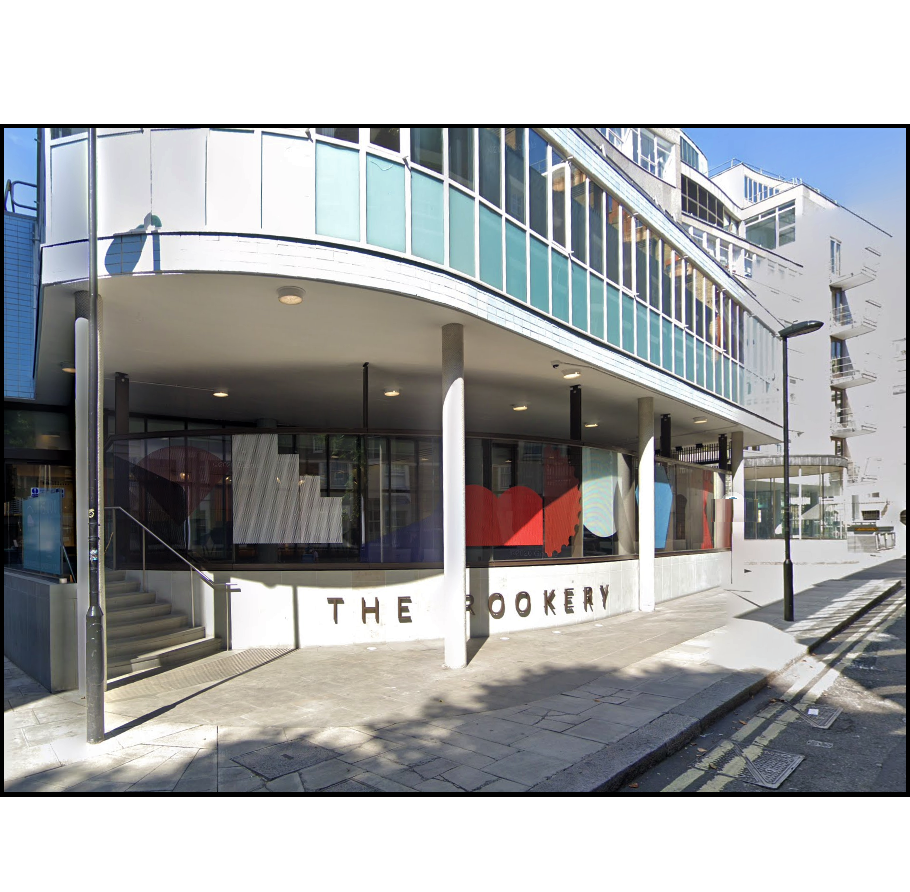
In the latest change to the brewery site, the southern section of Congress House has been internally redeveloped to provide rentable office space. This has, bizarrely, been christened ‘the Rookery’. I’d like to think the TUC knows what it’s doing when it comes to commemorating a slum district of poor migrant labourers, but giving rentable office space that name surely lacks sensitivity.
Corinthian House was sold off by the administrators of Arcadia, the successor company to Burton, in December 2020 for a cool £65 million. One of the current tenants is Pearl and Dean cinema advertising, and now you’ve read that, I doubt you’ll get the Pearl and Dean music out of your head for the rest of the day
The Meux family, incidentally, is extinct – but they went out in style. The last Lady Meux, wife of Sir Henry Meux, 3rd Baronet, was a banjo-playing American barmaid who would ride around London in a carriage drawn by zebras. A distant relative of the Kardashians, perhaps.

Nearest Station: Tottenham Court Road. Other stations close by are Leicester Square and Holborn.
Selected Bibliography:
Credits:
Comments are closed.
My mum worked in the Horseshoe Hotel as a waitress for many years during the 60s and 70s. I used to go to work with her during the school holidays. I used to tap dance on the Temple floor. The manager was a Mr Walker and his wife was from Manchester They had a siamese cat who I was particularly fond of and used to get the chef to cook fish for. I used to help my mum lay the tables of the restaurants by filling the mustard, salt and pepper pots. Many of the weigh ins for the fights in London were held in the Horseshoe Hotel and I have autographs from many fighters including Muhamad Ali and other celebs and actors who attended the Dominian next door as well as Trade Union personnel etc. It was a great place to work full of characters of people from all walks of life who had interesting stories to tell. Great memories for me
Thanks for this Cathie – vivid recollections like this make a place come alive for me. I had no idea the hotel was used for boxing weigh-ins.